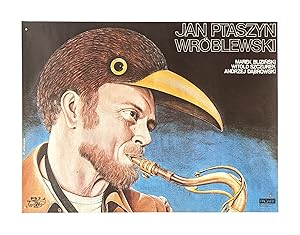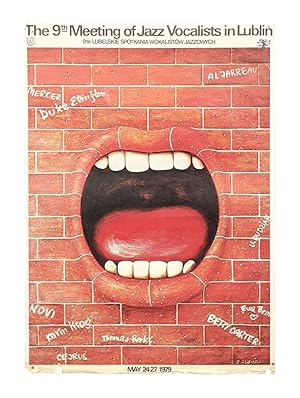Olbić ski Rafać (2 results)
Product Type
- All Product Types
- Books
- Magazines & Periodicals
- Comics
- Sheet Music
- Art, Prints & Posters (2)
- Photographs
- Maps
-
Manuscripts &
Paper Collectibles
Condition
- All Conditions
- New
- Used
Binding
- All Bindings
- Hardcover
- Softcover
Collectible Attributes
- First Edition
- Signed
- Dust Jacket
- Seller-Supplied Images
- Not Printed On Demand
Seller Location
Seller Rating
-
Polish Artistic Agency poster naming three jazz artists - Saxophonist Jan Ptaszyn Wróblewski in surreal raven hat
Publication Date: 1980
Seller: Capitol Hill Books, ABAA, Washington, DC, U.S.A.
Art / Print / Poster
Condition: Very Good. Text on poster: Jan Ptaszyn Wróblewski // Marek BliziĆ ski // Witold Szczurek // Andrej DÄ browski // P[olskie] S[towarzyszenie] J[azzowe] with trumpet logo. Date: 1980 presumed. Height x width: 67.5cm x 91.5cm. Printing information: lower right corner corner: PAGART logo // Polska Agencja Artystyczna // Plac ZwyciÈ stwa 9 // 00-078 Warszawa, Poland // Druk ZakĆ . Offset. W-wa, z. 9093, n. 6 000â ąS-58. Condition: No visual flaws OlbiĆ ski initially studied architecture at the Warsaw Polytechnic School. In the early 1980s, he emigrated to the United States, where he became a faculty member of New York's School of Visual Arts. He has received many awards for his work, including the Gold and Silver Medals from the Society of Illustrators and Art Directors Club of New York. In 1994 he was honored with the Prix Savignac in Paris, and in 1995 his work was chosen as the official poster in the "New York Capital of the World" competition. What is now seen as the height of Poland's poster creativity was a paradoxical by-product of the height of Communist Party control over public messaging related to the arts and cultural endeavors from the mid-1940s to almost the end of the century. What had been, before the war, and dating back as early as the mid-19th century, florid and often text-heavy formats, where fonts and textual layout bore a predominant or equal burden with imagery in conveying information, yielded in the five decades after World War II to the primacy of the image on its own. Visuals became mischievous, allegorical, satiric, and parabolic, and so fantastically creative that they could make innumerable apolitical or counterpolitical appeals while eluding the specific controls of verbal censorship.
-
Publicity for 9th Conference of Jazz Vocalists in Lublin - Vocalizing brick wall
Publication Date: 1979
Seller: Capitol Hill Books, ABAA, Washington, DC, U.S.A.
Art / Print / Poster
Condition: Very Good. Text on poster: The 9th Meeting of Jazz Vocalists in Lublin // 9te Lubelskie Spotkania Wokalistów Jazzowych // Heraldic shield of Lublin // P[olskie] S[towarzyszenie] J[azzowe] with trumpet logo // May 24-27 1979. Date: 1979. Height x width: 97cm x 68cm. Printing information: lower right corner: Druk: ZakĆ . Offset. W-wa, z. 9319, n. 2500 C-88. Condition: Irregular curling to left vertical edge, now creased flat; ~12 closed vertical tears (0.5cm-3cm) at bottom edge; crumpling (now flattened) and minor soiling; Left lower corner lacking, about 2 cm. OlbiĆ ski initially studied architecture at the Warsaw Polytechnic School. In the early 1980s, he emigrated to the United States, where he became a faculty member of New York's School of Visual Arts. He has received many awards for his work, including the Gold and Silver Medals from the Society of Illustrators and Art Directors Club of New York. In 1994 he was honored with the Prix Savignac in Paris, and in 1995 his work was chosen as the official poster in the "New York Capital of the World" competition. What is now seen as the height of Poland's poster creativity was a paradoxical by-product of the height of Communist Party control over public messaging related to the arts and cultural endeavors from the mid-1940s to almost the end of the century. What had been, before the war, and dating back as early as the mid-19th century, florid and often text-heavy formats, where fonts and textual layout bore a predominant or equal burden with imagery in conveying information, yielded in the five decades after World War II to the primacy of the image on its own. Visuals became mischievous, allegorical, satiric, and parabolic, and so fantastically creative that they could make innumerable apolitical or counterpolitical appeals while eluding the specific controls of verbal censorship.



